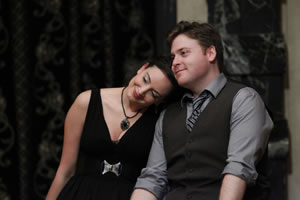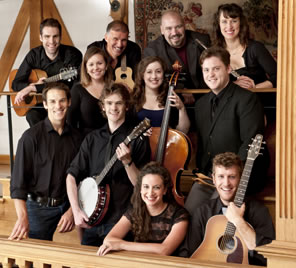The Duchess of Malfi
Sibling Rivalry Takes a Gruesome Turn,
And We Are the Better for It
By John Webster
American Shakespeare Center, Blackfriars Playhouse, Staunton, Va.
Saturday, September 8, 2012, C–6&7 (center stalls)
Directed by Jim Warren

Brothers Ferdinand (Patrick Earl) and the Cardinal (Patrick Midgley) in American Shakespeare Center's production of The Duchess of Malfi at the Blackfriars Playhouse. Below, the duchess (Stephanie Holladay Earl) and her husband, Antonio (Andrew Goldwasser). Photos by Tommy Thompson, American Shakespeare Center.
Kissing a poisoned Bible, four-way strangulation: death comes in many varieties in John Webster's The Duchess of Malfi. Life comes in many varieties, too: noble brothers so obsessed with the morality of others and torturing that morality into them, an honor-bound mercenary pursuing both evil and justice with destructive force, a promiscuous wife navigating her way to boudoir political power, a coterie of crazies dancing in an asylum. In the middle of all this is the title character, who gives over her power—and then her well-being and finally her life—to be married to her accountant.
I am as yet not fully embracing this play as the English Renaissance masterpiece director Jim Warren asserts it to be in his program notes, but I unequivocally consider his production of the play—as presented by the American Shakespeare Center's Tempt Me Further Tour troupe in a Blackfriars Playhouse preview run—a theatrical tour de force, with Stephanie Holladay Earl in the titular role as a glorious centerpiece.
ASC's touring companies seem to be on a two-year trend. Last year's tour featured John Ford's 'Tis Pity She's a Whore, in which Patrick Earl played the incestuously crazed Giovanni, who cuts out the heart of his sister after their sexual relationship results in her pregnancy. This year in The Duchess of Malfi, a play similar in tone and effect to 'Tis Pity, Earl plays the crazed Ferdinand whose relationship with his twin sister, Holladay Earl's duchess, is no less creepy if not overtly incestuous. Ferdinand insists that his widowed sister never remarry, and though his reasons may have more to do with immediate power and future wealth, Earl's Ferdinand turns this sibling rivalry into a sexually taut conflict. Meanwhile, their elder brother, the Cardinal, also does not want the Duchess to remarry, and in Patrick Midgley's slippery portrayal, his eye on immediate power and future wealth is clouded by a religious infatuation with morality (never mind that he's having an adulterous affair with Julia, luridly played by Bridget Rue).
 However, the Duchess falls in love with her steward, Antonio, sweetly played by Andrew Goldwasser, and she secretly marries him and bears three children by him. The two brothers enlist the services of Daniel de Bosola (Rick Blunt) to discover the father(s) of the “bastard children.” Bosola is the play's most complex character. He is known among others to be a true villain, but he speaks piercing lines of truth, and when he enters into the service of Ferdinand and the Cardinal to spy on the Duchess, he does so hesitatingly. Still, having done so, he proves totally loyal, even to the point of hanging the Duchess's infant children at Ferdinand's orders. Afterward he chides Ferdinand for the murderous order, and as he realizes how much his own morality has been abused, Bosola switches loyalties, only to lead to further inadvertent tragedy.
However, the Duchess falls in love with her steward, Antonio, sweetly played by Andrew Goldwasser, and she secretly marries him and bears three children by him. The two brothers enlist the services of Daniel de Bosola (Rick Blunt) to discover the father(s) of the “bastard children.” Bosola is the play's most complex character. He is known among others to be a true villain, but he speaks piercing lines of truth, and when he enters into the service of Ferdinand and the Cardinal to spy on the Duchess, he does so hesitatingly. Still, having done so, he proves totally loyal, even to the point of hanging the Duchess's infant children at Ferdinand's orders. Afterward he chides Ferdinand for the murderous order, and as he realizes how much his own morality has been abused, Bosola switches loyalties, only to lead to further inadvertent tragedy.
Yes, be forewarned, this production has a few disturbing scenes, from the Duchess caressing a severed hand in the dark to her own strangulation, from Julia foaming at the mouth after she kisses the poisoned Bible to the gasp-inducing sight of two swaddled infants hanging like garlic at the back of the stage. Then there's the scene with the crazies. Being unfamiliar with the play, I thought the asylum residents singing in a monotone and dancing like zombies was a Warren interpolation, but Webster's text points the way: “Here by a madman this song is sung, to a dismal kind of music,” reads his stage direction, and each madman takes a turn in the script. That scene is just weird, but like so much else in this production it's well done and morbidly funny.
What makes such scenes even more disturbing is the way Webster makes plot feints along the way, playing fast and loose with our own hearts and ever betraying our hopes and faith. Twice, characters we believe to be dead really aren't—and then they soon are. As Ferdinand slips further into his own insanity, we gain hope for a proper restitution—but Ferdinand's mental breakdown advances the social breakdown around him. When Bosola switches sides, we figure justice must finally be at hand, albeit a little late—we don't count on the mere darkness of night proving to be the only thing that can ultimately defeat him. It's not just evil that holds sway in Webster's drama—it's fate. In this play, chance is as dangerous as a covetous despot.
Nobody in this play is a cardboard cutout, either, and each cast member expertly keeps his or her character's ethical bearings in the shadows. Blunt anchors his Bosolo on the notion of service, even when in the end he tries to assist his victims in exacting revenge on the brothers. (Blunt's characterization does crack at one point when his Bosolo engages with Julia, who happens to be played by Blunt's real-life fiancée; their lust-driven come-ons are already carrying an extra-theatrical meaning when Bosolo speaks the line, “You know me, I am a blunt soldier,” which Blunt delivers with an ironic grin knowing the audience inevitably will laugh.) Antonio is a credible hero in that he becomes the object of the Duchess' devotion, and he claims to be nobly devoted to her amid all the danger surrounding him. However, Goldwasser makes it hard for us to fully respect his Antonio: while we know he has no ulterior motives and he's certainly likeable enough—he and Holladay Earl's duchess make a cute couple—this Antonio skates over courage rather than treading deeply in the sentiment. Midgley never tips his Cardinal's true purposes as he unfurls his plots; we believe him to be bad, but when we see him seeming to be heading down a road of redemption, we also believe he could be taking true steps. In this way, Midgley delivers a performance that is both riveting and disturbing, maximizing as it does the effects of his fearful actions by demolishing our faith in whatever goodness we want to see in him.
This play, though, belongs to the Duchess, and this production is Holladay Earl's crowning performance thus far with the ASC. Holladay Earl's Duchess ranges through a wide landscape of personalities. She is coy with her brothers, a scheming flirt seducing Antonio, a devoted wife and mother, a Machiavellian politician when her conflict with Ferdinand comes to a head, a weary refugee, and, finally, a destitute prisoner believing her husband dead. Holladay Earl drives this character's dramatic arc from a statuesquely ravishing beauty to a wasted, ragged ghost of a woman; her glint-eyed, flirtatious expressions become haunt-eyed stares. Never, though, is her spirit broken, nor does her love for Antonio ever waver, and what was the power to charm in the early scenes becomes a powerful pride in the prison scenes. Holladay Earl delivers her lines in these later scenes from a deep, deep place, thereby lifting the audience to a transcendent place. It only seems natural in Holladay Earl's performance that, despite the thoroughness with which Bosola executes the Duchess and her own desire to die, she lingers still for a while on stage, but for long, long after in our conscience.
Eric Minton
September 11, 1012
Comment: e-mail editorial@shakespeareances.com
Start a discussion in the Bardroom




 Find additional Shakespeareances
Find additional Shakespeareances